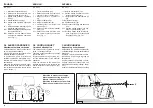
ENGLISH
SVENSKA
17
ITALIANO
3.0 NORME D’USO
3.1 TRASPORTO
Se si rendesse necessario trasportare
la macchina su di un lungo percorso,
questa può essere caricata sia su vagoni
ferroviari che su autocarri.
A tale scopo consultare «Dati tecnici»,
per il peso e le dimensioni specifi che.
Queste ultime sono molto utili per con-
trollare la possibilità di passaggio in zone
anguste.
La macchina viene solitamente fornita
libera da imballi e in posizione orizzon-
tale, è necessario quindi adottare un
sistema di sollevamento con gru e funi, o
catene, di adeguata portata, aggancian-
dolo ai punti di sollevamento predisposti
e segnalati con il simbolo «gancio» (16
Fig.3).
CAUTELA
Prima di procedere alle operazioni di
sollevamento, assicurarsi che even-
tuali elementi mobili della macchina
(ruote,castello...) siano ben bloccati.
Assicurarsi di avere una gru di por-
tata adeguata al sollevamento della
macchina.
Sollevare la macchina con estrema
cautela e trasferirlo lentamente, senza
scosse o movimenti bruschi.
PERICOLO
Le operazioni di sollevamento e
trasporto possono essere molto
pericolose se non effettuate con la
massima cautela: allontanare perciò
i non addetti; pulire, sgomberare e
delimitare la zona di trasferimento;
verifi care l’integrità e l’idoneità dei
mezzi a disposizione; non toccare i
carichi sospesi e rimanervi a distanza
di sicurezza; durante il trasporto, i
carichi non dovranno essere sollevati
più di 20 centimetri dal suolo.
3.0 USE
INSTRUCTIONS
3.1 TRANSPORT
If it becomes necessary to transport the
mabhine for a long distance, it can be
loaded onto a railway wagon or a truck.
For this purpose, consult «Technical
Features» for weight and specifi c dimen-
sions. The latter are very useful to check
the possibility of driving along all types
of roads.
The machine is generally supplied in
a horizontal position with no packing
material. It is therefore necessary to use
a system of hoisting with a crane and
cables, or chains of adequate capacity,
hooking onto the oachine at the hoisting
points marked with the «hook» symbol
(16 Fig. 3).
CAUTION
Before proceeding to the hoisting op-
erations, make sure that any any mo-
bile elements of the machine (wheels,
3rd point hitch...) are blocked.
Make sure to use a crane with an
adequate hoisting capacity to lift the
machine.
Hoist the machine with extreme cau-
tion and transfer it slowly, without
jerks or abrupt movements.
DANGER
The operations of hoisting and trans-
port can be very dangerous if not
carried out with the maximum caution;
persons not directly involved should
be moved away. Clean, evacuate the
area and delimit the transfer zone.
Check the state, condition and suit-
ability of the means at disposition.
Do not touch suspended loads, keep-
ing them at a safe distance.
During transport, the loads should
not be raised more than 20 cm. from
the ground.
3.0 ANVÄNDNING
3.1 TRANSPORT
Om redskapet måste transporteras en
lång sträcka kan det lastas på tågvagnar
eller lastbilar.
Se Tekniska data för vikt och mått. De
sistnämnda är mycket användbara för
att kontrollera fribredd och -höjd i trånga
utrymmen.
Vanligtvis levereras redskapet utan em-
ballage i horisontellt läge. Använd ett lyft-
system bestående av lyftkran och vajrar
(eller kedjor) med lämplig lyftkapacitet.
Haka fast dessa i avsedda lyftpunkter
som är markerade med krok-symbolen
(16 - fi g.3).
FÖRSIKTIGHET
Kontrollera att eventuella rörliga
redskapsdelar har spärrats ordentligt
innan lyftmomenten påbörjas.
Kontrollera att lyftkranens lyftkapaci-
tet är lämplig för lyft av redskapet.
Lyft redskapet försiktigt och transpor-
tera det långsamt utan snabba ryck
och rörelser.
FARA!
Kontrollera att aggregatets rörliga
delar (hjul, torn o.s.v.) är helt spärrade
innan du gör några lyftmoment.
Rengör, frigör och avgränsa transpor-
tområdet. Kontrollera att tillgängliga
lyftmedel är hela och lämpliga. Rör
inte vid upplyfta laster och håll dig
på ett säkert avstånd från dessa. Lyft
inte lasten mer än 20 cm från marken
under transporten.
















































